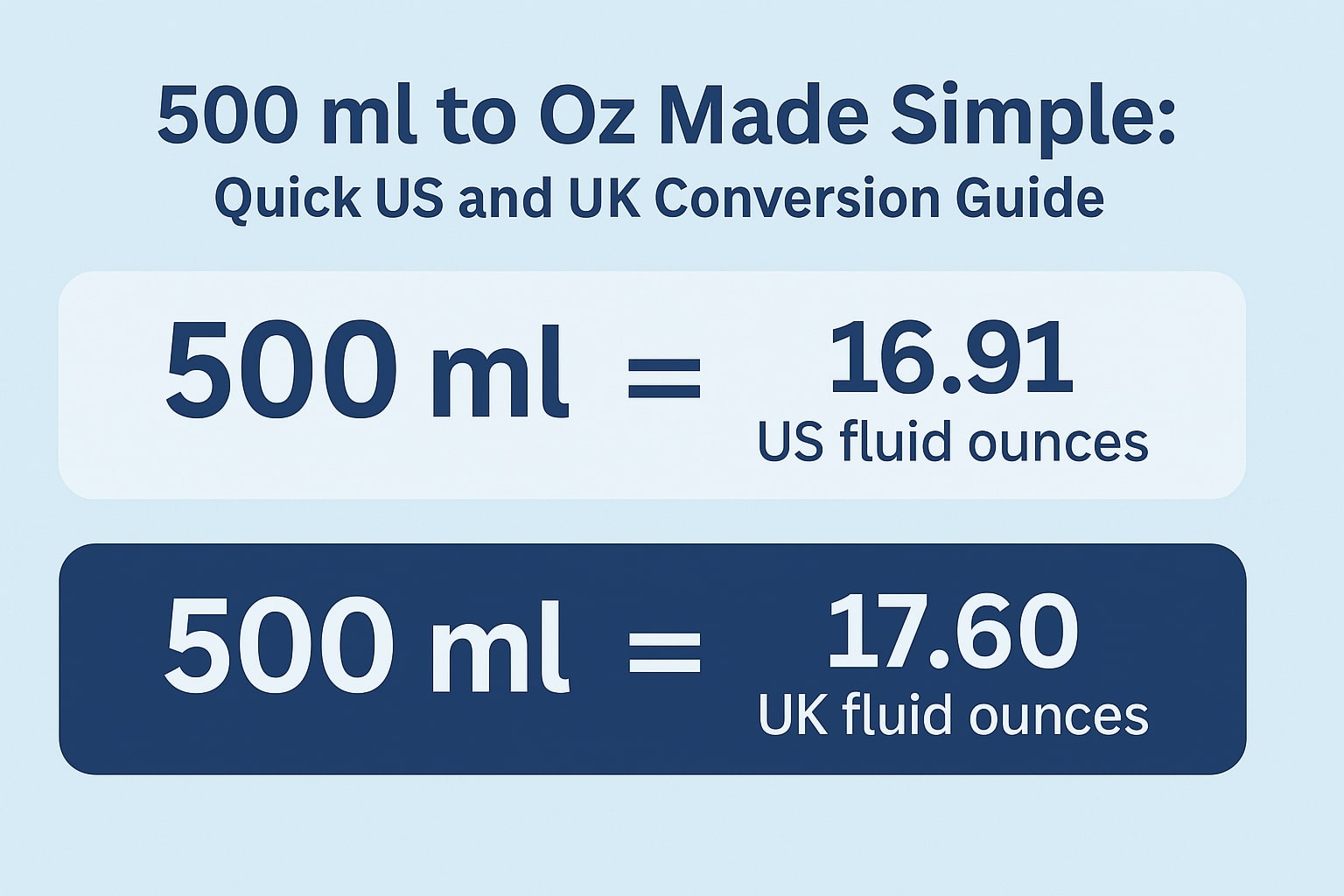You may come across 500 ml in many everyday tasks. Recipes from cookbooks or websites often use metric units. Drink bottles, juice cartons, and water packs list volumes in milliliters. Medicine labels may mention ml, especially in prescriptions or syrups. On the other hand, kitchen tools and local packaging may show ounces. This mismatch creates confusion.
You should know how to switch between milliliters and fluid ounces to avoid wrong measurements. It becomes more important when accuracy matters—like in baking, dosing medicine, or mixing drinks. Two different systems define fluid ounces: the US and the UK. Each one follows a different value, so your results will change depending on the method.
It helps to learn both systems. Once you understand the basic formulas and differences, converting 500 ml to oz becomes quick and easy. This guide will walk you through it step by step.
What Is 500 ml in Oz?
The answer changes based on the system you follow.
- 500 ml equals 16.91 US fluid ounces.
- 500 ml equals 17.60 UK fluid ounces.
You must confirm which measurement standard applies. Each system uses a separate definition, so the results differ. A small change in value can affect accuracy in cooking, medication, or mixing liquids. Always match the unit to your region or the source of the instruction.
What Is a Milliliter?
A milliliter measures liquid volume under the metric system. It stands as one-thousandth of a liter. Many countries use it as a standard. You will see it often on drink labels, cooking instructions, and medicine packaging. The metric system works in powers of ten, which makes calculations simple and consistent.
What Is a Fluid Ounce?
A fluid ounce is used in the US and UK systems. It measures liquid volume.
-
1 US fluid ounce = 29.574 ml
-
1 UK fluid ounce = 28.413 ml
The values look similar but are not the same. You should pick the right one based on the context.
Why Do US and UK Values Differ?
The US fluid ounce comes from the US gallon. The UK one is based on the imperial gallon. Each system uses a separate base volume. That creates a gap in results. You must stay alert to avoid using the wrong scale.
How to Convert 500 ml to Oz
The formula stays simple. You just divide.
To get US oz
500 ÷ 29.574 = 16.91 oz
To get UK oz
500 ÷ 28.413 = 17.60 oz
No complex tools are needed. A basic calculator works fine.
Handy Conversion Table
US Fluid Ounces
| Milliliters | Ounces |
|---|---|
| 1 ml | 0.03381 oz |
| 10 ml | 0.33814 oz |
| 100 ml | 3.3814 oz |
| 200 ml | 6.7628 oz |
| 500 ml | 16.91 oz |
UK Fluid Ounces
| Milliliters | Ounces |
|---|---|
| 1 ml | 0.03520 oz |
| 10 ml | 0.3520 oz |
| 100 ml | 3.520 oz |
| 200 ml | 7.040 oz |
| 500 ml | 17.60 oz |
These charts work well in your kitchen or lab. You can use them without any calculations.
Ounce vs. Fluid Ounce
An ounce measures weight. A fluid ounce measures volume.
Use ounces for dry items like flour and sugar.
Use fluid ounces for liquids like water or oil.
You must match the unit with the material.
Where You May Use This Conversion
Cooking
You may see ml in recipes from Europe. You must convert it to ounces if you follow it in the US or UK.
Medicine
Some bottles show ml. If your doctor uses ounces, you should convert them to track the right dose.
Drinks
Soft drink cans often use ml. You may prefer comparing them in ounces when shopping.
Best Tools to Convert Quickly
-
Conversion charts help during cooking.
-
Online calculators like ConvertUnits give fast results.
-
Mobile apps offer help on the go.
-
Measuring cups with both units make it easier.
You don’t need complex formulas. Use any of these tools for fast results.
Quick Questions and Answers
How many US ounces are in 500 ml?
Answer: 16.91 oz
How many UK ounces are in 500 ml?
Answer: 17.60 oz
Can I convert without tools?
Yes. Use 29.574 for the US and 28.413 for the UK. Divide 500 by the number.
Can I use tablespoons?
Yes, 1 US tablespoon equals about 14.79 ml. Two tablespoons make up one fluid ounce.
Final Thoughts
You often need to switch between ml and oz. Both US and UK fluid ounces use different values. That gap affects results in cooking, medicine, and other tasks. You must know the difference to avoid wrong measurements.
Use the correct formula or tool. Keep a chart nearby. Check the label to know which system applies. Once you learn the method, you can handle any recipe or liquid measurement easily.
You now know how to convert 500 ml to oz with confidence.

